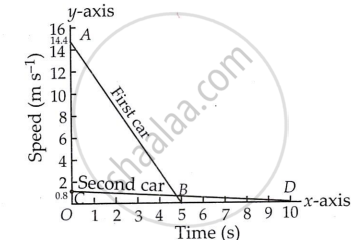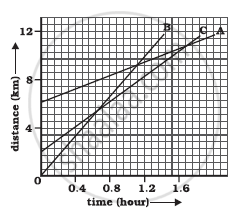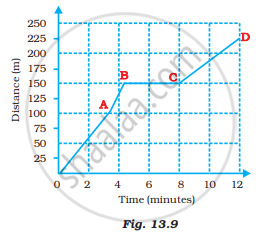Advertisements
Advertisements
प्रश्न
A driver of a car travelling at 52 km h−1 applies the brakes and accelerates uniformly in the opposite direction. The car stops in 5 s. Another driver going at 3 km h−1 in another car applies his brakes slowly and stops in 10 s. On the same graph paper, plot the speed versus time graphs for the two cars. Which of the two cars travelled farther after the brakes were applied?
उत्तर
The data given in this numerical problem are in different units. So, we should first convert km h-1 unit into m s-1 unit.
For first car:
Initial velocity u = 52 km h-1
= `(52 "km")/(1 "h")`
= `(52 xx 1000 "m")/(1 xx 3600 "s")`
= 14.4 s-1
Final velocity, v = 0 km h-1 = 0.0 m s-1
Time taken, t = 5s
For second car:
Initial velocity, u = 3 km h-1
= `(3 "km")/(1"h")`
= `(3 xx 1000 "m")/(1 xx 3600 "s")`
= 0.8 ms-1
Final velocity, v = 0 km h-1 = 0.0 m s-1
Time taken, t = 10s

The area under a moving body's speed-time graph indicates the distance it has traveled.
So, Distance travelled by the first car = Area of the triangle AOB
= `1/2 xx "OB" xx "AO"`
= `1/2 xx 14.4` ms-1 × 5s
= `1/2 xx 14.4 xx 5 "m"`
= 36 m
Similarly, distance travelled by the second car = area of triangle COD.
= `1/2 xx "OD" xx "CO"`
= `1/2 xx 0.83 m s^-1 xx 10 s`
= `1/2 xx 0.83 xx 10 "m"`
= 4.1 m
Thus, the second car travels 4.1 m and the first car travels 36 m before coming to rest.
So, the first car travelled farther after the brakes were applied.
APPEARS IN
संबंधित प्रश्न
Given figure shows the distance-time graph of three objects A, B and C. Study the graph and answer the following questions:

- Which of the three is travelling the fastest?
- Are all three ever at the same point on the road?
- How far has C travelled when B passes A?
- How far has B travelled by the time it passes C?
Which of the following distance-time graphs shows a truck moving with speed which is not constant?
What can you say about the motion of a body whose distance-time graph is a straight line parallel to the time axis ?
Fill in the following blank with suitable word :
The slope of a distance-time graph indicates ………………….. of a moving body.
Fill in the following blank with suitable word :
The slope of a speed-time graph of a moving body gives its………………………..
A student draws a distance-time graph for a moving scooter and finds that a section of the graph is horizontal line parallel to the time axis. Which of the following conclusion is correct about this section of the graph?
What are the uses of the graphical study of motion?
Two students were asked to plot a distance-time graph for the motion described in Table A and Table B.
Table A
| Distance moved (m) | 0 | 10 | 20 | 30 | 40 | 50 |
| Time (minutes) | 0 | 2 | 4 | 6 | 8 | 10 |
Table B
| Distance moved (m) | 0 | 5 | 10 | 15 | 20 | 25 |
| Time (minutes) | 0 | 1 | 2 | 3 | 4 | 5 |

The graph given in Figure 13.2 is true for
Boojho goes to the football ground to play football. The distance-time graph of his journey from his home to the ground is given in Figure 13.9.

(a) What does the graph between points B and C indicate about the motion of Boojho?
(b) Is the motion between 0 to 4 minutes uniform or nonuniform?
(c) What is his speed between 8 and 12 minutes of his journey?
What do you infer if
- Distance – time graph is a straight line.
- The velocity-time graph is curved.
- Displacement time is zigzag.
